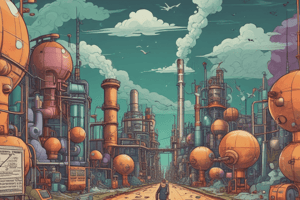Podcast
Questions and Answers
Which type of hazard involves factors that can cause harm without necessarily changing the substance or composition of the material?
Which type of hazard involves factors that can cause harm without necessarily changing the substance or composition of the material?
- Mechanical hazards
- Chemical hazards
- Physical hazards (correct)
- Biological hazards
Prolonged exposure to certain vibrations can cause which of the following disorders?
Prolonged exposure to certain vibrations can cause which of the following disorders?
- Cardiovascular disorders
- Neurological disorders
- Musculoskeletal disorders (correct)
- Respiratory disorders
Which type of hazard involves exposure to substances that can cause harm through their chemical properties?
Which type of hazard involves exposure to substances that can cause harm through their chemical properties?
- Physical hazards
- Chemical hazards (correct)
- Biological hazards
- Mechanical hazards
Which type of hazard involves exposure to living organisms or their byproducts that can cause harm?
Which type of hazard involves exposure to living organisms or their byproducts that can cause harm?
What type of hazard can lead to hearing damage?
What type of hazard can lead to hearing damage?
Which of the following can cause musculoskeletal disorders through prolonged exposure?
Which of the following can cause musculoskeletal disorders through prolonged exposure?
Exposure to ionizing or non-ionizing radiation is associated with which type of hazard?
Exposure to ionizing or non-ionizing radiation is associated with which type of hazard?
Which of the following involves substances that can ignite and cause fires?
Which of the following involves substances that can ignite and cause fires?
What type of hazard involves substances that can cause harm through ingestion, inhalation, or skin contact?
What type of hazard involves substances that can cause harm through ingestion, inhalation, or skin contact?
Corrosive substances that can cause damage to living tissues or materials fall under which type of hazard?
Corrosive substances that can cause damage to living tissues or materials fall under which type of hazard?
In which type of hazard do exposure to living organisms or their byproducts cause harm?
In which type of hazard do exposure to living organisms or their byproducts cause harm?
What type of hazard involves factors in the environment that can cause harm without necessarily changing the substance or composition of the material?
What type of hazard involves factors in the environment that can cause harm without necessarily changing the substance or composition of the material?
What type of hazard involves exposure to extremely hot or cold environments that can pose risks such as heat stroke or hypothermia?
What type of hazard involves exposure to extremely hot or cold environments that can pose risks such as heat stroke or hypothermia?
Exposure to what types of substances is a part of chemical hazards?
Exposure to what types of substances is a part of chemical hazards?
Which of the following is an example of a chemical hazard?
Which of the following is an example of a chemical hazard?
Flashcards are hidden until you start studying
Study Notes
Types of Hazards
- Physical hazards involve factors that can cause harm without changing the substance or composition of the material, such as vibrations that can cause disorders like carpal tunnel syndrome.
- Ergonomic hazards can cause musculoskeletal disorders through prolonged exposure to poor posture, repetitive movements, or vibrations.
Chemical Hazards
- Chemical hazards involve exposure to substances that can cause harm through their chemical properties, such as corrosive substances that can damage living tissues or materials.
- Examples of chemical hazards include exposure to substances that can ignite and cause fires, or substances that can cause harm through ingestion, inhalation, or skin contact.
Biological Hazards
- Biological hazards involve exposure to living organisms or their byproducts that can cause harm, such as exposure to bacteria, viruses, or toxins.
Radiological Hazards
- Radiological hazards involve exposure to ionizing or non-ionizing radiation, which can cause harm.
Environmental Hazards
- Environmental hazards involve factors in the environment that can cause harm without changing the substance or composition of the material, such as extreme temperatures that can cause heat stroke or hypothermia.
- Noise hazards can lead to hearing damage.
Studying That Suits You
Use AI to generate personalized quizzes and flashcards to suit your learning preferences.




